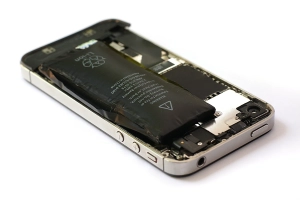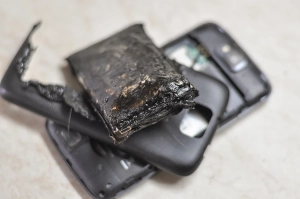Dangers of Lithium Batteries
In today’s digital workplaces, IT devices like laptops, tablets, and smartphones are essential tools. But these everyday items could pose an unexpected fire hazard—all due to the lithium polymer or lithium-ion (LiPo or Li-ion) batteries that power them.
As a safety consultant, I’ve seen firsthand how overlooked defective or misused devices containing lithium batteries can lead to incidents.
It is important that all organisations carry out a suitable and sufficient risk assessment on the hazards associated with lithium-based batteries. Ultimately, this will identify who could be affected, the level of risk, and the control measures that are needed to ensure the harm caused by lithium battery issues is mitigated.
This blog post explains how to spot the warning signs, understand the risks, and implement safe practices when dealing with potentially faulty lithium-based batteries in your portable equipment.
What are Lithium Batteries?
A lithium battery is a rechargeable battery commonly used in smartphones, tablets, laptops, drones, tools and other portable devices. They use lithium-ion or lithium polymer chemistry and come in a flat, flexible pouch instead of a rigid outer case.
They are particularly useful in portable equipment for the following reasons:
- Lightweight & Thin: Fits in slim devices such as tablets.
- High Energy: Long battery life in a compact size.
- No Memory Effect: You don’t have to fully drain it before recharging.
Whilst their use is beneficial, they can pose a significant fire hazard if they become damaged or defective.
What can cause Lithium Batteries to become damaged or defective?
There are many reasons for a lithium-based battery to become damaged or defective. These include:
1. Physical Damage
- Puncturing or crushing the casing can breach the battery’s outer structure, leading to internal short circuits.
- Dropping or impact on a device, which may deform internal layers or break welds within the battery.
- Bending or twisting (more common with LiPo packs) can damage the thin internal cell structure.
2. Electrical Abuse
- Overcharging (charging above the recommended voltage, typically 4.2 V per Li-ion cell) causes heat buildup and gas generation.
- Deep discharging (below ~2.5 V per cell) can cause chemical changes inside the battery and can cause permanent capacity loss.
- Overcurrent or short-circuiting leads to excessive heat and internal damage.
- Using the wrong charger (incorrect voltage/current profile) can damage cells.
3. Thermal Stress
- Overheating (e.g. from external heat sources, direct sunlight, or poor ventilation during charging) can degrade the electrolyte and cause thermal runaway.
- Freezing temperatures (charging below 0 °C) can cause issues with the lithium chemistry, causing internal short circuits.
- Rapid temperature cycling (hot-to-cold) can cause expansion/contraction stress and microcracks within the structures of the battery.
4. Manufacturing Defects
- Contaminants inside the cell can damage internal parts of the battery over time.
- Poor-quality sealing may allow moisture ingress.
- Incorrect chemical mixtures or assembly errors can shorten lifespan or cause failure.
5. Ageing & Wear
- Capacity fade occurs naturally due to chemical changes, breakdown, and electrode degradation.
- Swelling from gas buildup happens after repeated cycles or when cells are stressed.
- High cycle count (many charge/discharge cycles) weakens structural integrity.
Recognising Faulty Devices: What to Look Out For
Swollen Devices
A bulging case or screen lifting from the body could indicate battery swelling.
- Burn Marks or Discolouration: Especially near the charging port or ventilation grills.
- Overheating: Devices that become unusually hot while idle or during charging.
- Leaking Fluid: Corrosive electrolyte may leak from damaged cells—this is both toxic and a fire risk.
- Cracked or Punctured Battery Cases: Often due to drops, pressure, or careless handling.
Leaking electrolyte
- A damaged battery may possibly leak electrolyte, which is a fluid or gel-like substance.
Heat
- The device can become abnormally hot during everyday use or charging (even without heavy usage).
The device may also heat up while not being used or is turned off.
Unusual Smells
- Such as sweet, metallic, acidic, solvent-like, other chemical smells, burning plastic or an acrid smell. These can occur before the visible signs of defects appear.
Physical Damage
- If the device has been dropped, punctured, or crushed, assume the battery may be damaged even if there are no immediate signs.
Burn Marks
- You might see discolouration, residue, or scorching near charging ports or the battery area if a rupture is happening.
Poor Performance
- The battery charges very quickly or drains rapidly.
- Sudden device shutdowns or large sudden percentage drops in battery level.
Device Misbehaviour
- Due to power irregularities, the device may experience lag, shutdown, reboot, or behave erratically.
The power button might stop responding correctly.
There can, of course, be many more.
Batteries should never be disposed of in general waste streams. A licensed disposal contractor must be used.
Why are such defects a problem?
Swollen or otherwise defective lithium batteries are dangerous because the swelling indicates internal chemical instability, usually caused by overcharging, physical damage, misuse or ageing. This instability leads to a buildup of gas inside the battery pouch, resulting in increased internal pressure. If the pressure continues to rise, the battery can rupture, releasing flammable and toxic gases. In some cases, this can trigger thermal runaway. This is a chain reaction that leads to fire or explosion.
Due to these risks, swollen or otherwise damaged lithium batteries should never be used or charged, and they must be handled and disposed of carefully.
Please see the links below, which show examples of different types of lithium fires in laptops, phones, tablets and other devices:
https://youtu.be/jTbUP0sGQT8?si=J5aYkVJNIpWHnQvc
https://youtu.be/j6HDS-qF6Cw?si=fF2vZDAX0cQOAHrR
https://youtu.be/91BIk4pBUE0?si=7cZnbsFEUFDy-Bdh
https://youtu.be/8nz5ijXcckI?si=qVGbFjOA5eJ7uiDW
As you can see in the examples above, the batteries can violently combust with little or no warning. The reaction generates a significant amount of heat, potentially reaching temperatures of 700-1,000°C or higher during thermal runaway.
This intense heat:
- Can cause nearby materials to ignite or melt or start a fire
- Cause burn and other injuries to people
- Makes the fire difficult to extinguish
- May lead to explosions if the battery casing ruptures or other cells ignite
In confined spaces, such fires pose serious risks to people, equipment, and structures. They also release toxic gases, adding to the danger.
What to do if you suspect a device is showing signs of battery damage or malfunction?
1. Stop Using It Immediately
- Turn off the device and unplug it from any power source if it is safe to do so.
- Do not attempt to recharge or continue using the device under any circumstances.
- Report the issue to your Line Manager and the responsible person on site.
If a battery is starting to combust, you may see a rapid expansion of the pack, smell burning or hear fizzing or popping sounds. This is a dangerous situation.
- Evacuate yourself and others from the area.
- Raise the alarm.
- Contact the emergency services.
- Stay out of the building until the emergency services advise that it is safe to re-enter.
2. Handle With Care
- Do not puncture, crush, or apply pressure to a device or battery you suspect to be damaged.
- Wear gloves and eye protection if swelling, leaking, or unusual odours are present.
- Move the device using insulated tools or gently place it in a non-flammable container or in a designated safe space outside the building.
3. Have robust procedures for the site
Your risk assessment will guide your development of on-site procedures. Such procedures can include:
- Having an agreed-upon and identified point to store devices with defective or potentially defective batteries. Ideally, this should be separate from the main building and utilise a dedicated fireproof box designed to hold lithium-based batteries safely.
- Understanding who to report defective devices to and ensuring this is done in person.
- Understanding and ensuring that the “sign over” process to the responsible site person is completed correctly.
- Ensuring that responsibilities for storage and disposal are clearly defined.
On-site procedures can vary significantly between different sites and industries. Employees should be versed in the procedure for the site on which they work.
Emergency Procedures
Knowing what to do in an emergency is crucial, especially if a device with a defective battery starts to smoke or catch fire.
Emergency procedures can vary from site to site. You should follow the emergency procedures for the site you work on.
If the Battery or device smokes or Ignites
- Evacuate the area immediately and close the door behind you
- Raise the alarm to alert others
- Call the emergency services.
- Do not re-enter the room until the Fire Service has confirmed that it is safe to do so.
Some workplaces may have the necessary equipment for extinguishing lithium battery fires and ensure employees have been specially trained to handle such emergencies. Water must not be used to try to extinguish the device/battery. Lithium reacts with water and can make the situation worse. Only equipment recommended by a specialist supplier should be used.
If employees have not received the correct training, they should raise the alarm, evacuate the premises and wait for the emergency services to arrive. Employees should never put themselves in harm’s way.
Conclusion
Lithium batteries are an essential component of modern workplaces, but they can pose significant risks if not properly managed. By following safe charging practices, storing them correctly, and preparing for emergencies, employers can protect their people, equipment, and business. Awareness and training are key — when everyone knows what to look for and how to respond, incidents can be prevented or contained quickly.
Contact us today to discuss your requirements.
*Disclaimer: Please note that it is the duty of the employer to carry out a suitable and sufficient risk assessment to ensure that adequate controls are in place to protect workers against the dangers of lithium-based batteries. This page is for information purposes only and does not constitute legal advice. The information on this page is intended as an overall introduction to the dangers of lithium batteries. Practical Safety Ltd aims to avoid, but accepts no liability, if any information stated is incorrect or out of date.







